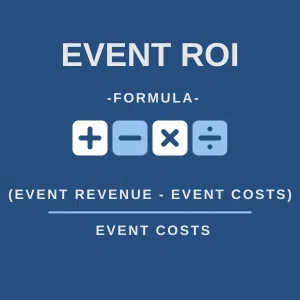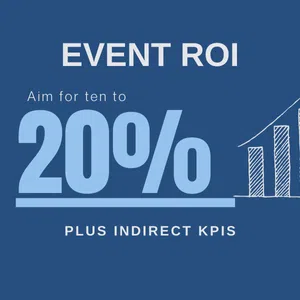Maximize the ROI of Events
Investing in events is an excellent way for businesses and organizations to pursue various strategic goals. These range from motivating your workforce, penetrating new markets, and reinforcing relations with your existing customers.
As with any type of investment, events come with both risks and opportunities. They can contribute to your profitability, have a neutral impact, or negatively affect your bottom line. 41% of marketers believe that activation events is the most effective marketing channel. However, the effectiveness of each event is mostly dependent on its planning and execution.
Let’s explore in greater detail the concept of ROI of events, how to measure it, and some helpful advice on organizing high-ROI events.

What is Event ROI?

In order to calculate event ROI, companies must take into account both the costs of the event and its benefits.
The first part is usually the easier one. It involves summing all investments made to create and run the event, such as venue fees, marketing costs, staffing expenses, and so on. (see how to budget for a corporate event for a simple excel setup).
Evaluating the financial benefits is a bit more complicated, as these encompass all direct and indirect rewards obtained from hosting the events.
Direct rewards include any revenue generated from the event (as well as donations or sponsorships), while indirect rewards refer to factors such as enhanced brand recognition or sales leads generated during the happening.
Direct KPIs
- Revenue
- Direct Sales
- Leads
- Customer Actions
- Website Traffic
Indirect KPIs
- Brand Awareness
- Customer Satisfaction
- Employee Engagement
- Media Coverage
- Social Media Engagement
- Thought Leadership
- Partnerships
Calculating these two components gives businesses a clear idea of whether a business has achieved its desired results through the event(s).
Conducting this analysis has several benefits.

For example, a safety and compliance event may maximize ROI by going over safety procedures and awarding department with zero or low work incidents. Their ROI would be measured, in part, by each year’s performance.
Additionally, an event ROI analysis supplies key data points that inform decisions about what type of content to include during an event’s lifecycle – from pre-event promotion strategies to post-event follow-up tactics – so as to continuously optimize investments over time. This is especially important for events like product launches or brand activations as they develop marketing strategies.
Finally, measuring an event’s ROI also helps business owners differentiate performance across different channels like digital or physical platforms in order to budget appropriately based on previous successes.
| Type of Event | KPI to Measure |
| Networking Events | – Number of new contacts made – Quality of leads generated – Strength of connections built – Brand visibility and awareness within the industry – Potential for future partnerships or collaborations |
| Activation Events (e.g., experiential marketing) | – Brand impressions and reach – Social media engagement and buzz – Customer experience and satisfaction – Lead generation and capture – Sales or trial sign-ups directly attributable to the event |
| Brand/Product Launches & Grand Openings | – Pre-orders and initial sales figures – Media coverage and impressions – Social media mentions and sentiment – Website traffic and product page views – Customer feedback and reviews |
| All-Hands Training & Sales Meetings | – Improved sales team knowledge and skills – Increased close rates – Higher individual sales performance – Reduced employee turnover – Improved employee morale and engagement |

How to Measure Event ROI?
When creating goals and objectives for an event, it is essential to consider the desired outcomes that will benefit yourself as well as any stakeholders involved. This could include:
- increasing sales or leads generated from attendees;
- improving customer satisfaction;
- building relationships with potential partners or influencers in attendance.
Pro Tip:
It is also helpful to set specific targets such as “generate ten new leads” or “increase customer satisfaction by 20%.” Setting clear expectations upfront will help you evaluate whether or not your efforts were effective after the fact.
Once you have identified desired outcomes for your event, it is time to establish metrics for evaluation purposes so that progress towards achieving those goals can be tracked over time.
These metrics could include things like:
- number of attendees registered versus total capacity;
- amount spent per attendee; percentage of people who completed surveys after attending;
- number of leads generated during/after the event;
- the present value of additional projected revenues generated as a result of the event due to increased brand recognition, improved customer satisfaction scores, or positive reviews.
These metrics must be measurable so that accurate data can be collected throughout the process, which will later be used when calculating ROI of the event.
By adding up all expenses associated with hosting an event, subtracting them from any revenue generated directly or indirectly as a result of the event, and then dividing this figure by the total cost associated with running said event, one can calculate the return on investment.
Measuring Event ROI isn’t rocket science but does require careful planning and execution beforehand, along with tracking results afterward.

Some Helpful Tips on How to Maximize Event ROI
Maximizing event ROI requires the implementation of a comprehensive pre-event strategy. This typically includes the creation of an effective marketing plan, a social media campaign, and networking efforts with potential attendees.
Onsite strategies mostly focus on increasing engagement, excitement, and participation among attendees. This could include interactive activities or games as well as providing incentives such as discounts or freebies. Find ideas on how to make your conference stand out on this article.
Post-event follow-up is also essential in order to maximize ROI. This could involve sending out surveys or emails asking for feedback from attendees so that organizers can learn what worked well and where they need improvement for future events.
By utilizing the strategies discussed in this article, event and production companies can maximize their return on investment and create successful events. Learn more about how to leverage events for marketing.
An Example of a Successful Event with High ROI
To help you get acquainted with these concepts, let’s work through an example of an internal corporate event. In this case, an internal sales meeting for training similar to what we accomplished for BEHR Paints and their Vegas conference.
Scenario: A company hosts a multi-day internal sales training event for its sales team.
Event Costs: $1,000,000
ROI Target KPI: Improve sales performance by 20%
Number of Attendees: 1000
Estimating Increased Sales:
Gather Baseline Sales Data:
Collect data on the sales team’s performance before the training. This includes:
- Average deal size
- Number of deals closed per sales rep per year
- Total annual sales revenue
Calculate Current Revenue:
Let’s assume the following baseline data:
- Average deal size: $50,000
- Number of deals closed per sales rep per year: 10
- Total current annual revenue: 1000 reps * 10 deals/rep * $50,000/deal = $500,000,000
Project Revenue with Improved Performance:
With a 20% improvement in sales performance, the new annual revenue would be:
$500,000,000 * 1.20 = $600,000,000
Calculate the Increase in Revenue:
Increase in revenue: $600,000,000 – $500,000,000 = $100,000,000
Calculate ROI:
ROI = (Increase in Revenue – Event Costs) / Event Costs
ROI = ($100,000,000 – $1,000,000) / $1,000,000 = 99
ROI = 9900%
Conclusion:
With 1000 attendees, if the internal sales training event results in a 20% improvement in sales performance, it would generate an ROI of 9900%. This indicates a substantial return on the investment in the training event.
Important Notes:
This is a simplified calculation and doesn’t account for other factors that might influence sales, such as market conditions or competitor actions.
The actual ROI may vary depending on the specific circumstances of the event and the company’s sales performance.
This calculation focuses solely on the financial aspect of ROI.
Additional benefits, such as improved employee morale, skills, and knowledge, are not factored in, but would play a significant role in overall success of the business year after year.
This concept also works if you are looking to attract new talent or retain employees with incentive trips with excursions for employees or company retreats.

What is a good ROI for an event?

Seasoned event planning companies, like Event Solutions, can help you conduct a careful analysis of event costs such as venue rental, catering services, marketing materials, and personnel, as well as make decisions that can maximize the direct and indirect revenues generated by your event. Finally, they can conduct a post-event assessment to determine if the event was profitable and to what extent.
If you are planning a corporate wellness retreat, product launch, grand opening, all hands company meeting, or other corporate event, submit your RFP to our team.
Contact Our Event Planning Agency
Read More:
Nationwide Locations
Los Angeles, CA
San Francisco, CA
Las Vegas, NV
Dallas/Fort Worth, TX
Chicago, IL
Miami, FL
New York, NY
Latest Projects
2025 Event Solutions
BEHR’s 2025 ConferenceMay 30, 2025 - 5:49 pm2024 Event Solutions
Video Game Product Launch PartyOctober 22, 2024 - 2:57 pm- San Bernardino County Employees’ 2024 Summer PicnicJuly 11, 2024 - 2:55 pm
Best of the Best
- NBA 2K Launch PartyNovember 2, 2022 - 6:57 pm
- NEOM Gala & ConferenceSeptember 29, 2022 - 7:02 pm
- Premium Energy Drink Company Gets Employees Hyped UpJuly 25, 2022 - 8:49 pm
Resources
 2019-2020ROR and Its Importance in Corporate EventsMay 30, 2025 - 3:30 pm
2019-2020ROR and Its Importance in Corporate EventsMay 30, 2025 - 3:30 pm Multigenerational Meetings for HRMarch 4, 2025 - 7:54 am
Multigenerational Meetings for HRMarch 4, 2025 - 7:54 am Best Holiday Party Venues in the Bay AreaOctober 23, 2024 - 12:00 pm
Best Holiday Party Venues in the Bay AreaOctober 23, 2024 - 12:00 pm



